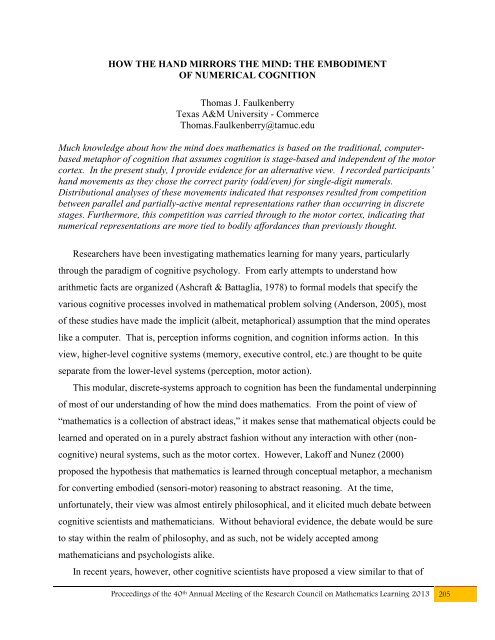2013 Conference Proceedings - University of Nevada, Las Vegas
2013 Conference Proceedings - University of Nevada, Las Vegas
2013 Conference Proceedings - University of Nevada, Las Vegas
- No tags were found...
You also want an ePaper? Increase the reach of your titles
YUMPU automatically turns print PDFs into web optimized ePapers that Google loves.
HOW THE HAND MIRRORS THE MIND: THE EMBODIMENTOF NUMERICAL COGNITIONThomas J. FaulkenberryTexas A&M <strong>University</strong> - CommerceThomas.Faulkenberry@tamuc.eduMuch knowledge about how the mind does mathematics is based on the traditional, computerbasedmetaphor <strong>of</strong> cognition that assumes cognition is stage-based and independent <strong>of</strong> the motorcortex. In the present study, I provide evidence for an alternative view. I recorded participants’hand movements as they chose the correct parity (odd/even) for single-digit numerals.Distributional analyses <strong>of</strong> these movements indicated that responses resulted from competitionbetween parallel and partially-active mental representations rather than occurring in discretestages. Furthermore, this competition was carried through to the motor cortex, indicating thatnumerical representations are more tied to bodily affordances than previously thought.Researchers have been investigating mathematics learning for many years, particularlythrough the paradigm <strong>of</strong> cognitive psychology. From early attempts to understand howarithmetic facts are organized (Ashcraft & Battaglia, 1978) to formal models that specify thevarious cognitive processes involved in mathematical problem solving (Anderson, 2005), most<strong>of</strong> these studies have made the implicit (albeit, metaphorical) assumption that the mind operateslike a computer. That is, perception informs cognition, and cognition informs action. In thisview, higher-level cognitive systems (memory, executive control, etc.) are thought to be quiteseparate from the lower-level systems (perception, motor action).This modular, discrete-systems approach to cognition has been the fundamental underpinning<strong>of</strong> most <strong>of</strong> our understanding <strong>of</strong> how the mind does mathematics. From the point <strong>of</strong> view <strong>of</strong>“mathematics is a collection <strong>of</strong> abstract ideas,” it makes sense that mathematical objects could belearned and operated on in a purely abstract fashion without any interaction with other (noncognitive)neural systems, such as the motor cortex. However, Lak<strong>of</strong>f and Nunez (2000)proposed the hypothesis that mathematics is learned through conceptual metaphor, a mechanismfor converting embodied (sensori-motor) reasoning to abstract reasoning. At the time,unfortunately, their view was almost entirely philosophical, and it elicited much debate betweencognitive scientists and mathematicians. Without behavioral evidence, the debate would be sureto stay within the realm <strong>of</strong> philosophy, and as such, not be widely accepted amongmathematicians and psychologists alike.In recent years, however, other cognitive scientists have proposed a view similar to that <strong>of</strong><strong>Proceedings</strong> <strong>of</strong> the 40 th Annual Meeting <strong>of</strong> the Research Council on Mathematics Learning <strong>2013</strong> 205




